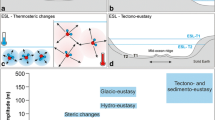Abstract
A method of analyzing GRACE satellite-to-satellite ranging data is presented which accentuates signals from diurnal ocean tides and dampens signals from long-period non-tidal phenomena. We form a time series of differences between two independent monthly mean gravity solutions, one set computed from range-rate data along strictly ascending arcs and the other set computed from data along descending arcs. The solar and lunisolar diurnal tides having alias periods longer than a few months, such as K 1, P 1, and S 1, present noticeable variations in the monthly ascending and descending ‘difference’ solutions, while the climate-related signals are largely cancelled. By computing tidal arguments evaluated along the actual GRACE orbits, we decompose and estimate residual tidal signals with respect to our adopted prior model GOT4.7. The adjustment in the tidal height is small yet significant, yielding maximum amplitudes of 4 cm mostly under the Antarctic ice shelves and ~1 cm in general at spatial scales of several hundred kilometer. Moreover, the results suggest there are possible 1-cm errors in the tide model even over oceans well-covered by decades of radar altimetry missions. Independent validation of such small adjustments covering wide areas, however, is difficult, particularly with limited point measurements such as tide gauge.
Similar content being viewed by others
References
Bosch W, Savcenko R, Flechtner F, Dahle C, Mayer-Guerr T, Stammer D, Taguchi E, Ilk K-H (2009) Residual ocean tide signals from satellite altimetry, GRACE gravity fields, and hydrodynamic modeling. Geophys J Int 178: 185–1192. doi:10.1111/j.1365-246X.2009.04281.x
Cartwright DE, Ray RD (1990) Oceanic tides from Geosat altimetry. J Geophys Res 95: 3069–3090
Chen J, Wilson C, Seo K-W (2007) S2 tide aliasing in GRACE time-variable gravity solutions. J Geod 83: 679–687. doi:10.1007/s00190-008-0282-1
Egbert GD, Erofeeva SY (2002) Efficient inverse modeling of barotropic ocean tides. J Atmos Ocean Technol 19(2): 183–204
Egbert G, Erofeeva S, Han S-C, Luthcke S, Ray R (2009) Assimilation of GRACE tide solutions into a numerical hydrodynamic inverse model. Geophys Res Lett 36: L20609. doi:10.1029/2009GL040376
Han D, Wahr J (1995) The viscoelastic relaxation of a realistically stratified Earth, and a further analysis of post glacial rebound. Geophys J Int 120: 287–311
Han S-C, Jekeli C, Shum C (2004) Time-variable aliasing effects of ocean tides, atmosphere, and continental water mass on monthly mean GRACE gravity field. J Geophys Res 109: B04403. doi:10.1029/2003JB002501
Han S-C, Shum C, Matsumoto K (2005) GRACE observations of M2 and S2 ocean tides below the Filchner-Ronne and Larsen Ice Shelves, Antarctica. Geophys Res Lett 32: L20311. doi:10.1029/2005GL024296
Han S-C, Ray R, Luthcke S (2007) Ocean tidal solutions in Antarctica from GRACE inter-satellite tracking data. Geophys Res Lett 34: L21607. doi:10.1029/2007GL031540
Han S-C, Rowlands DD, Luthcke SB, Lemoine FG (2008) Localized analysis of satellite tracking data for studying time-variable Earth’s gravity fields. J Geophys Res 113: B06401. doi:10.1029/2007JB005218
Heiskanen WA, Moritz H (1967) Physical geodesy. W.H. Freeman, San Francisco
Knudsen P, Andersen O (2002) Correcting GRACE gravity fields for ocean tide effects. Geophys Res Lett 29: 1–4
Lefèvre F (2002) Modélisation de la marée océanique à l’échelle globale par la méthode des éléments finis avec assimilation de données altimétriques, CLS-DOS-NT-01.416/SALP-RP-MA-E2-21060-CLS. Ramonville Saint-Agne
Lemoine J-M, Bruinsma S, Loyer S, Biancale R, Marty J-C, Perosanz F, Balmino G (2007) Temporal gravity field models inferred from GRACE data. Adv Space Res 39: 1620–1629. doi:10.1016/j.asr.2007.03.062
Luthcke SB, Rowlands DD, Lemoine FG, Klosko SM, Chinn D, McCarthy JJ (2006) Monthly spherical harmonic gravity field solutions determined from GRACE inter-satellite range-rate data alone. Geophys Res Lett 33: L02402. doi:10.1029/2005GL024846
Moore P, King MA (2008) Antarctic ice mass balance estimates from GRACE: tidal aliasing effects. J Geophys Res 113: F02005. doi:10.1029/2007JF000871
Moritz H, Mueller II (1987) Earth rotation: theory and observation. Ungar/Continuum, New York
Pavlis DE, Poulose S, McCarthy JJ (2006) GEODYN Operations manuals contractor report. SGT Inc, Greenbelt
Ray RD (1999) A global ocean tide model from TOPEX/POSEIDON altimetry: GOT99.2, NASA Tech, Memorandum 1999-209478. Goddard Space Flight Center, Greenbelt
Ray RD (2008) A preliminary tidal analysis of ICESat laser altimetry: Southern Ross Ice Shelf. Geophys Res Lett 35: L02505. doi:10.1029/2007GL032125
Ray RD, Eanes RJ, Egbert GD, Pavlis NK (2001) Error spectrum for the global M2 ocean tide. Geophys Res Lett 28: 21–24
Ray RD, Egbert GD (2004) The global S1 tide. J Phys Ocean 34: 1922–1935
Ray RD, Luthcke SB (2006) Tide model errors and GRACE gravimetry: towards a more realistic assessment. Geophys J Int 167: 1055–1059. doi:10.1111/j.1365-246X.2006.03229.x
Rodell M et al (2004) The global land data assimilation system. Bull Am Meteorol Soc 85: 381–394
Rowlands DD, Ray RD, Chinn DS, Lemoine FG (2002) Short-arc analysis of intersatellite tracking data in a mapping mission. J Geod 76: 307–316. doi:10.1007/s00190-002-0255-8
Schrama EJO, Wouters B, Lavallée DA (2007) Signal and noise in Gravity Recovery and Climate Experiment (GRACE) observed surface mass variations. J Geophys Res 112: B08407. doi:10.1029/2006JB004882
Seidelmann PK (1992) Explanatory supplement to the astronomical almanac. University Science Book, Mill Valley
Shum CK et al (1997) Accuracy assessment of recent ocean tide models. J Geophys Res 102(C11): 25,173–25,194
Author information
Authors and Affiliations
Corresponding author
Rights and permissions
About this article
Cite this article
Han, SC., Ray, R.D. & Luthcke, S.B. One centimeter-level observations of diurnal ocean tides from global monthly mean time-variable gravity fields. J Geod 84, 715–729 (2010). https://doi.org/10.1007/s00190-010-0405-3
Received:
Accepted:
Published:
Issue Date:
DOI: https://doi.org/10.1007/s00190-010-0405-3




